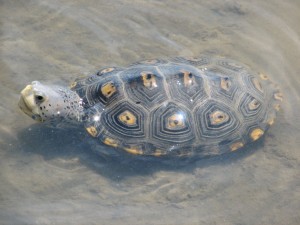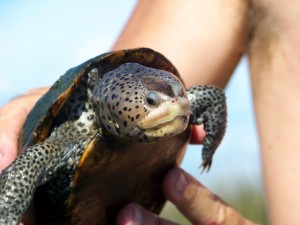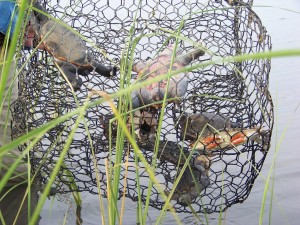It is hard to say one turtle is more beautiful than another but this is one beautiful turtle! The diamondback terrapin is the only brackish water turtle in the United States. These turtles can be easily distinguished from other species by their light colored skin with dark spots, and their choice of habitat – salt marshes.
Terrapins inhabit creeks within marshes close to where they were born and rarely range from their natal home. They require dry ground for nesting. Terrapins spend their time basking in lagoons near the surface or on open mudflats at low tide. They feed primarily on shellfish, preferring snails and bivalves, but will also feed on small crabs, shrimp, worms, fish, and occasionally vegetation.
The females are larger than the males and have shorter tails. Mature females typically lay 6 to 10 eggs and will nest more than once in the same year. Nesting begins in late April in our part of the country and females laying multiple clutches will do so every 16 days. The sex of the offspring is determined by the nest temperature (warmer than 29˚C = females) so generally the eggs in the upper part of the nest are female. Unlike sea turtles, female terrapins approach the nesting beach at high tide during daylight hours. Most of the nests we find in Santa Rosa County are near salt bush (Baccharis sp.) but we have found them in open areas or near debris like driftwood. They also differ from sea turtles in that young head away from open water preferring the plants of the marsh. The heaviest predation is on the eggs and young. The dominant nest raider is the raccoon. Hatchlings are preyed upon by raccoons, otters, skunks, crows, and sea gulls; adults have few predators.
Terrapin populations have declined over the last 150 years. In the late 19th century it became very popular to eat them and the demand for the animal became an economic dynamo for many coastal fishermen. Terrapin researchers from the University of Alabama at Birmingham found a newspaper article from that time period that discussed a terrapin farm in Mobile County that had 25,000 terrapins; suggesting they were once very common. With the increase in the popularity for food their numbers decreased, this caused an increase in price and a decline in their popularity. The introduction of the crab trap in the 20th century became problematic for them. Terrapins swim into traps and can not reach the surface to breathe. In some states a “by-catch reduction device” or BRD is required on crab traps. Studies of these in New Jersey and Florida showed they have no significant impact on the crab catch but do reduce the number of terrapins captured. BRDs are not currently required in Florida as commercial traps are actively fished and bycatch removed when crabs are harvested. “Derelict” crab traps are those that are not actively being fished, killing all sorts of aquatic life. Derelict crab trap removal events which removes this potential hazard to turtles and to blue crabs as well.
To learn more about Florida’s Recreational Blue Crab Regulations Click Here
We have been conducting a monitoring program assessing the status of Terrapins in the Panhandle since 2006 and have found at least one in every coastal county between Alabama and the Apalachicola River. We have identified five nesting beaches and believe that one population has between 25-50 individuals within it (likely much lower numbers than historically found). The marsh turtle status is certainly of concern for many biologists.
To learn more about terrapins and the crab trap removal program visit the following websites or call your local extension office. For more information on obtaining a bycatch reduction device (BRD) for your recreational crab traps contact Rick O’Connor, 850-475-5230.
http://escambia.ifas.ufl.edu/marine/2012/11/30/diamonds-in-the-marsh
http://myfwc.com/fishing/saltwater/trap-debris
- Marine Creatures of the Northern Gulf – Jellyfish - May 2, 2025
- Our Environment: Part 7 – Managing the Human Population - May 2, 2025
- Marine Creatures of the Northern Gulf – Sponges - April 25, 2025



